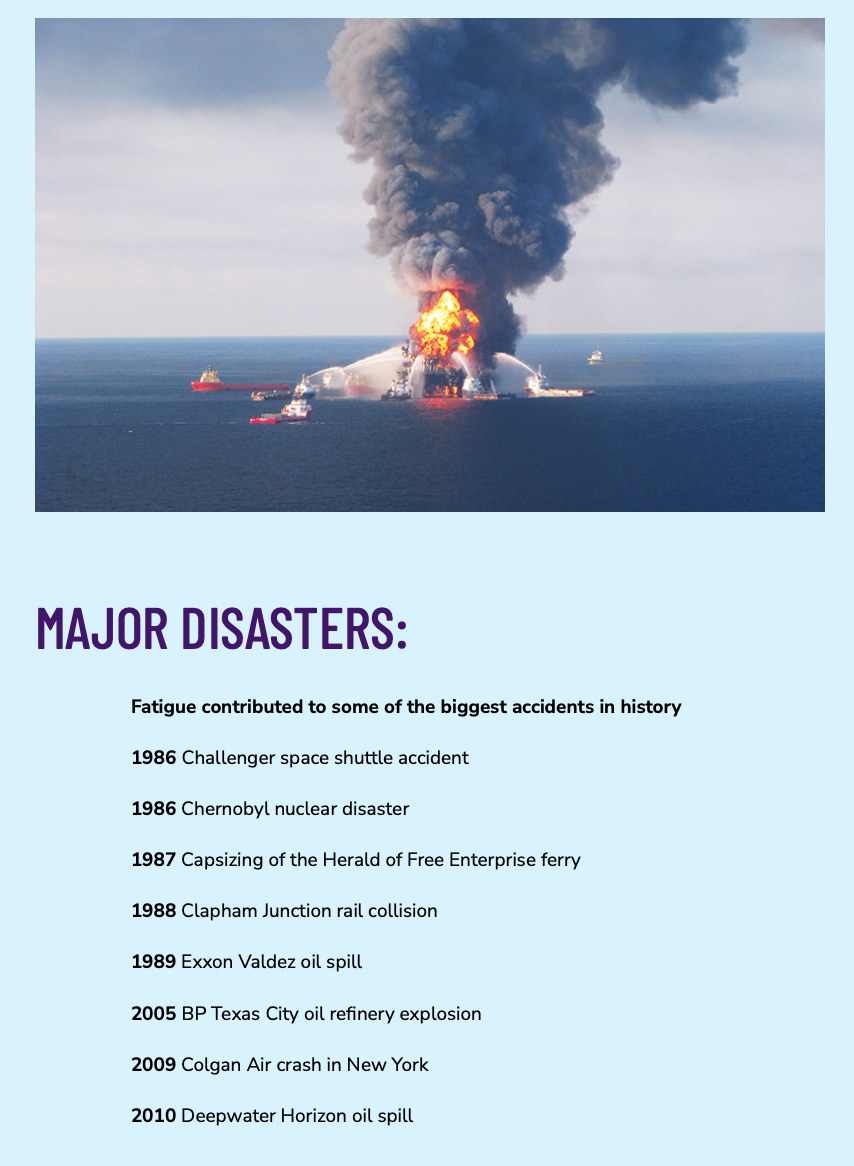Investigating Accidents with Fatigue as a Cause

Fatigue as a Root Cause
I was recently reading an article in IOSH Magazine titled “Fatigue in the Broadcast Industry.” It had the following graphic:

When I reviewed the list of the accidents that fatigue contributed to, I thought:
“I’m not sure that’s right.”
I had read reports about most of the accidents and knew the role of fatigue in:
- the decision to launch the Challenger
- the Exxon Valdez Captain leaving the bridge (although alcohol may have played a bigger role).
- the Colgan Air Crash
But I wasn’t sure about the remainder. For example, I don’t remember fatigue playing a part in the Texas City oil refinery explosion. Then I remembered this article:
Thinking about this caused me to think about how TapRooT® RCA helps people look for fatigue issues. Read on for more information…
Exploring Fatigue as a Cause
In the TapRooT® System, fatigue is not by itself a root cause. But fatigue is a part of two root causes.
First, under Work Direction – Selection of Worker: fatigued is one of the possible choices. In other words, the supervisor or manager assigned someone to do the work when they should have been able to tell that they were too fatigued and thus, too error-prone to perform the work.

The Root Cause Tree® Dictionary asks you to consider excessive overtime, working a second job, and other factors that could cause a worker to be obviously fatigued. The dictionary has questions about regulations about work hours, microsleeps, and automatic behavior syndrome as clues to the fatigue level of the worker. All these make determining the “fatigued” root cause more justifiable.
Note in the dictionary under “fatigued” root cause also point to the “scheduling NI” root cause in the case that poor scheduling of work could lead to fatigue. Also, if the supervisor assigned someone to perform the work that violated company policies about limits on overtime, the dictionary asks the investigator to consider the Management System-related near root cause of Standards, Policies, and Administrative Controls (SPAC) Not Used.
The other Basic Cause Category that includes fatigue as part of the evaluation is the root cause under the Human Engineering – Human-Machine Interface: monitoring alertness NI.
This root cause looks for boredom or loss of alertness while monitoring a fairly stable indicator. This phenomenon is sometimes called the “vigilance decrement.” The dictionary provides ideas to evaluate if the human was lulled into a state where detecting a change in an indication was unlikely.
Human Performance Troubleshooting Guide

But how do you know to consider these root causes or Basic Cause Categories? You are guided in the Root Cause Tree® Diagram by the Human Performance Troubleshooting Guide (the 15 Questions).
The very first question under “Human Performance Difficulty” is:
“1. Was a person excessively fatigued, impaired,
upset, distracted, or overwhelmed?“
The Root Cause Tree® Dictionary then has questions to help the investigator answer this question, including questions about:
- the supervisor’s ability to detect the fatigue level of the worker,
- the shift scheduling,
- sleep disorders,
- violations of state or federal laws requiring rest/sleep periods,
- working more than 16 hours in a row, and
- the design of the job that requires excessive monitoring that leads to a vigilance decrement for normal workers.
If your root cause analysis tool doesn’t cause investigators to consider factors of fatigue, vigilance decrement, excessive work hours, shift/work scheduling, and company policies, then your investigators probably won’t identify fatigued workers or job design as a cause of a human error that contributed to the accident or incident.
Learn More About TapRooT® Root Cause Analysis
Learn more about how TapRooT® Root Cause Analysis guides investigators to the fixable causes of human error by registering for one of our Public TapRooT® Root Cause Analysis Courses or holding a course at your site. Some of the courses you may consider include:
- 2-Day Root Cause Analysis Course
- 3-Day Virtual Root Cause Analysis Course
- Equifactor® Equipment Troubleshooting & TapRooT® Root Cause Analysis Course
- 5-Day TapRooT® Advanced Root Cause Analysis Team Leader Course
Just click on the link above to learn more about each course.
To see our schedule of courses around the world, CLICK HERE.
To contact one of our implementation experts about a course at your site, CLICK HERE or call 865-539-2139.




